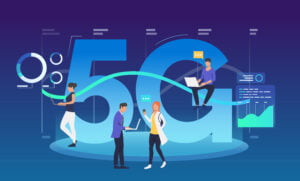Wireless communication has undergone a remarkable evolution over the past few decades, transforming how we connect, communicate, and interact with the world around us.
From the early days of 1G, which introduced basic mobile telephony, to the revolutionary advancements of 5G, enabling ultra-fast internet speeds and low latency, each generation of wireless technology has brought significant improvements and new possibilities.
As we stand on the brink of another technological leap, the anticipation surrounding 6G, the sixth generation of wireless communication, is growing.
6G promises to surpass the capabilities of its predecessor, 5G, by delivering unprecedented speeds, near-instantaneous connectivity, and enhanced reliability.
This next-generation technology is poised to revolutionize various industries, from healthcare and transportation to smart cities and beyond. The development of 6G is not just about faster internet; it is about creating a seamless and intelligent network that can support the ever-increasing demands of a hyper-connected world.
In this blog post, we will delve into the exciting world of 6G, exploring what it is, its key features, the technological innovations driving its development, and the potential applications that could transform our lives. Join us as we embark on a journey to understand how 6G is set to become the next frontier in wireless communication, shaping the future in ways we can only begin to imagine.
What is 6G?
6G, or the sixth generation of wireless communication technology, represents the next major leap in mobile networking. While 5G is still in the early stages of global deployment, researchers and engineers are already looking ahead to what 6G can offer. The goal of 6G is not only to enhance the features introduced by 5G but also to introduce groundbreaking advancements that will redefine connectivity and communication.
Definition and Basic Concepts
6G aims to achieve data transfer speeds that are orders of magnitude faster than 5G, with theoretical peak speeds reaching up to 1 terabit per second (Tbps). This means that downloading an entire high-definition movie could take mere seconds.
Beyond speed, 6G will focus on reducing latency to near-zero levels, enabling real-time communication for applications where even the slightest delay is critical, such as in autonomous vehicles or remote surgery.
Differences Between 5G and 6G
While 5G is characterized by its high-speed, low-latency connections and ability to support a massive number of devices simultaneously, 6G will push these boundaries even further. Key differences include:
- Speed: 6G is expected to deliver speeds up to 100 times faster than 5G.
- Latency: 6G aims to achieve ultra-low latency, with response times as low as 1 millisecond or less.
- Capacity: Enhanced capacity to support the exponential growth of connected devices and data traffic.
- Intelligence: Integration of artificial intelligence (AI) and machine learning (ML) to optimize network performance dynamically and predictively.
- Frequency Bands: Utilization of terahertz (THz) frequency bands, which offer more bandwidth than the millimeter waves used in 5G.
Projected Timeline for Development and Deployment
The journey to 6G is still in its early stages, with research and development (R&D) ramping up across the globe.
Major milestones in the 6G timeline include:
- 2020-2025: Fundamental research and initial trials. Universities, research institutions, and leading tech companies are exploring the theoretical underpinnings of 6G and conducting preliminary experiments.
- 2025-2030: Standardization and large-scale testing. Industry standards will begin to take shape, and extensive testing will be conducted to refine the technology.
- 2030 Onwards: Commercial deployment. Widespread adoption of 6G networks is expected to begin, offering new services and applications that leverage the full potential of this next-generation technology.
As 6G development progresses, it promises to unlock new opportunities and drive innovation in ways we have yet to fully comprehend. The capabilities of 6G will extend far beyond faster internet speeds, encompassing a holistic transformation of how we interact with and experience the digital world.
Key Features of 6G
6G, the next frontier in wireless communication, is poised to introduce a plethora of groundbreaking features that will redefine connectivity and communication. Building upon the foundation laid by 5G, 6G aims to surpass its predecessor in speed, latency, reliability, and intelligence. Here are some of the key features that will distinguish 6G from previous generations:
Ultra-High Speeds and Bandwidth Capabilities
One of the most anticipated features of 6G is its ability to deliver unparalleled data transfer speeds. With theoretical peak speeds reaching up to 1 terabit per second (Tbps), 6G will enable lightning-fast downloads, seamless streaming of high-definition content, and real-time data-intensive applications.
This exponential increase in speed will open up new possibilities for immersive experiences, such as holographic telepresence and ultra-high-definition virtual reality (VR).
Ultra-Low Latency
Reducing latency to near-zero levels is another crucial aspect of 6G. Ultra-low latency ensures instantaneous communication, making it possible for applications to respond in real time without any perceptible delay.
This feature is essential for mission-critical applications, including autonomous vehicles, remote surgery, and industrial automation, where split-second decisions can have life-saving implications.
Enhanced Reliability and Stability
6G will prioritize reliability and stability, ensuring consistent performance even in challenging environments. Advanced error correction techniques and robust network architectures will minimize packet loss and downtime, providing users with a seamless and uninterrupted experience.
This increased reliability will be especially critical for applications requiring continuous connectivity, such as remote monitoring and control systems.
Integration of AI and Machine Learning
Artificial intelligence (AI) and machine learning (ML) will play a central role in optimizing 6G networks. By leveraging AI algorithms, 6G systems can dynamically adapt to changing network conditions, predict traffic patterns, and allocate resources more efficiently. Intelligent network management will enhance overall performance, improve energy efficiency, and enable predictive maintenance, leading to a more reliable and sustainable communication infrastructure.
Advanced Security Features
Security is paramount in 6G networks, given the proliferation of cyber threats and the growing importance of safeguarding sensitive data. 6G will introduce advanced encryption techniques, authentication mechanisms, and intrusion detection systems to protect against emerging threats.
Additionally, secure-by-design principles will be integrated into the core of 6G architecture, ensuring that security is not an afterthought but a fundamental aspect of network design.
Technological Innovations Driving 6G
The development of the 6G is fueled by a myriad of technological innovations that are pushing the boundaries of what is possible in wireless communication.
From leveraging new frequency bands to integrating cutting-edge antenna technologies, researchers and engineers are exploring a wide range of advancements to unlock the full potential of 6G.
Here are some of the key technological innovations driving the development of 6G:
Terahertz Frequency Bands
6G is expected to operate in the terahertz (THz) frequency bands, which offer significantly more bandwidth compared to the millimeter waves used in 5G. Terahertz waves have the potential to support extremely high data rates, making them ideal for ultra-fast communication applications.
However, harnessing the capabilities of terahertz frequencies presents unique technical challenges, including propagation loss and signal attenuation, which researchers are actively working to overcome.
Advanced Antenna Technologies
Massive Multiple Input Multiple Output (MIMO) and smart antenna technologies will play a crucial role in enhancing the performance of 6G networks. Massive MIMO systems, which utilize hundreds or even thousands of antennas to transmit and receive signals simultaneously, can significantly increase spectral efficiency and improve coverage and capacity.
Smart antennas, equipped with beamforming and beam-steering capabilities, enable more precise signal transmission, reducing interference and enhancing network reliability.
Quantum Communication and Computing Integration
Quantum communication is poised to revolutionize secure communication in 6G networks. By leveraging the principles of quantum mechanics, such as entanglement and superposition, quantum communication protocols can ensure unconditional security and privacy for sensitive data transmission.
Furthermore, the integration of quantum computing capabilities into 6G infrastructure will enable complex computational tasks to be performed with unprecedented speed and efficiency, opening up new possibilities for AI-driven optimization and data analytics.
Holographic Beamforming
Holographic beamforming is a novel technique that promises to revolutionize antenna design and signal processing in 6G networks. Unlike traditional phased-array antennas, which steer beams in a limited number of directions, holographic beamforming allows for the creation of dynamic and adaptable beam patterns in three-dimensional space. This enables more precise control over signal transmission, better coverage in challenging environments, and improved interference mitigation, leading to enhanced network performance and reliability.
AI and Machine Learning for Network Optimization
AI and machine learning algorithms will be integral to optimizing the performance of 6G networks. By analyzing vast amounts of data in real time, AI-powered systems can adaptively allocate resources, predict network congestion, and proactively optimize network parameters to meet evolving user demands.
Machine learning techniques, such as reinforcement learning and deep neural networks, will enable autonomous network management and self-optimization, reducing operational costs and enhancing overall network efficiency.
The Future Impact of 6G
As 6G emerges on the horizon, its potential impact on society, technology, and the economy is poised to be profound. Building upon the advancements of previous generations, 6G promises to revolutionize connectivity and communication in ways that will shape the future for generations to come. Here are some of the key areas where 6G is expected to make a significant impact:
Transformative Potential Across Various Industries
6G will serve as a catalyst for innovation across a wide range of industries, including healthcare, transportation, manufacturing, entertainment, and more.
By enabling ultra-high-speed, low-latency communication, 6G will unlock new possibilities for real-time remote healthcare services, autonomous transportation systems, immersive augmented reality experiences, and advanced industrial automation solutions.
These transformative applications have the potential to enhance efficiency, productivity, and quality of life on a global scale.
Societal Implications and Benefits
The widespread adoption of 6G will have far-reaching societal implications, shaping the way we live, work, and interact with each other.
From enabling seamless communication in smart cities to bridging the digital divide in underserved communities, 6G has the potential to create more inclusive and equitable societies.
Additionally, 6G-powered innovations in education, entertainment, and social networking will foster greater connectivity and collaboration, enriching the human experience and strengthening social bonds.
Redefining Connectivity and Communication
6G will redefine what it means to be connected in an increasingly digital world. With ultra-high-speed data transmission and near-zero latency, 6G networks will enable seamless communication between people, devices, and machines, blurring the lines between the physical and virtual realms.
Whether it’s immersive virtual reality experiences, real-time remote collaboration, or instant access to vast amounts of information, 6G will empower individuals and organizations to communicate and interact in ways that were previously unimaginable.
Preparing for a 6G-Enabled World
As we look ahead to the future of 6G, it’s essential to start preparing for the opportunities and challenges that lie ahead.
This includes investing in research and development to accelerate the deployment of 6G networks, fostering collaboration between industry stakeholders to ensure interoperability and standardization, and addressing regulatory and policy considerations to promote innovation while safeguarding privacy and security.
By proactively embracing the potential of 6G, we can pave the way for a more connected, intelligent, and sustainable future for all.
Conclusion
In conclusion, 6G represents a transformative leap forward in wireless communication, promising ultra-high speeds, ultra-low latency, and enhanced reliability. Its potential impact spans across industries, fostering innovation and connectivity on a global scale.
To prepare for this future, it’s crucial to stay informed and engaged with 6G developments. By embracing the possibilities and collaborating to overcome challenges, we can create a brighter, more connected future for all.
In summary, as we journey towards a 6G-enabled world, let’s seize the opportunities it presents and work together to build a faster, smarter tomorrow.












